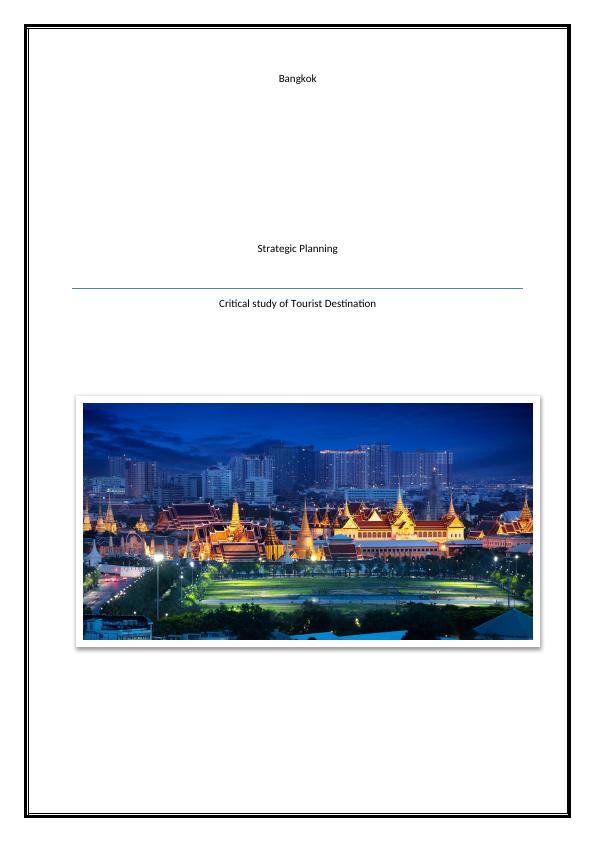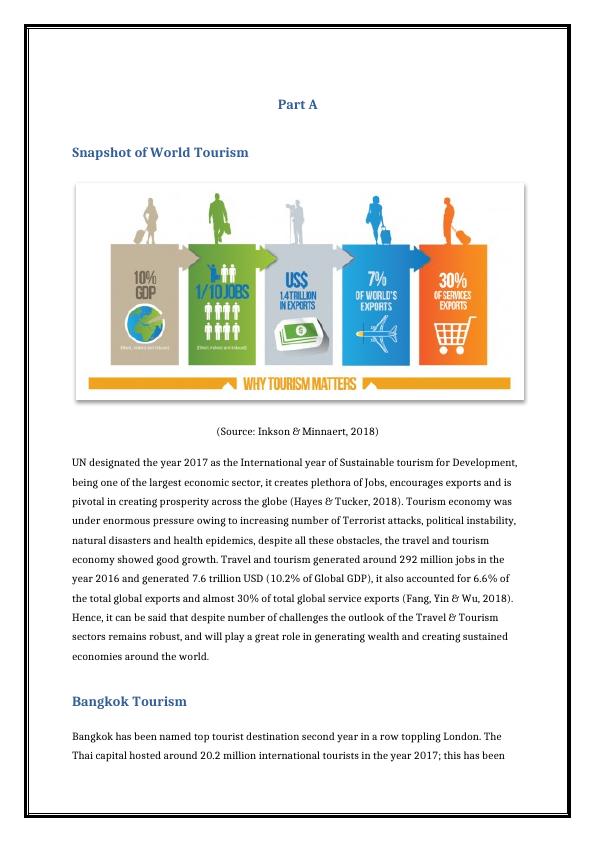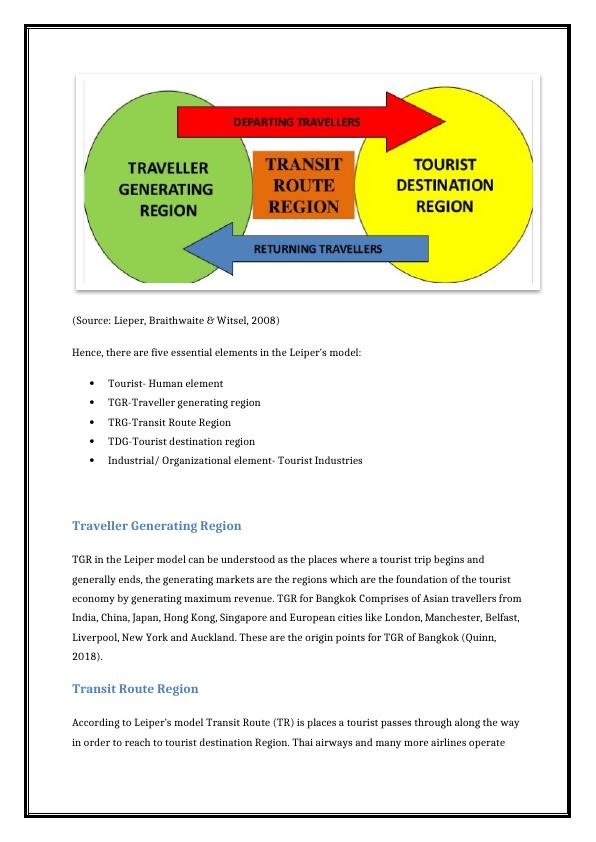Critical Study of Tourist Destination: Bangkok
27 Pages6617 Words457 Views
Added on 2023-06-13
About This Document
This article provides a critical study of Bangkok as a tourist destination. It explores the socio-cultural, environmental, and economic impact of tourism on the city. The article discusses Leiper's WTS model, TALC curve, and government policies for sustainable tourism.
Critical Study of Tourist Destination: Bangkok
Added on 2023-06-13
ShareRelated Documents
Bangkok
Strategic Planning
Critical study of Tourist Destination
Strategic Planning
Critical study of Tourist Destination

Table of Content
Part A........................................................................................................................................................................................ 3
Snapshot of World Tourism............................................................................................................................................3
Bangkok Tourism................................................................................................................................................................ 3
Leiper’s WTS Model........................................................................................................................................................... 4
Traveller Generating Region..................................................................................................................................... 5
Transit Route Region.................................................................................................................................................... 5
Tourist Destination Regions......................................................................................................................................6
Human Element...............................................................................................................................................................9
Environment..................................................................................................................................................................... 9
Economic Impact on Bangkok....................................................................................................................................... 9
Positive Impact on Tourism.......................................................................................................................................9
Negative Impact on the Economy.........................................................................................................................10
Environmental Impact on the Destination............................................................................................................10
Positive Impact on Environment..........................................................................................................................10
Negative impact on Environment.........................................................................................................................11
Socio- cultural impact of tourism activities..........................................................................................................11
Positive impact on of Tourism...............................................................................................................................11
Negative impact on Tourism...................................................................................................................................12
Part B...................................................................................................................................................................................... 13
Butler TALC curve............................................................................................................................................................ 13
Part A........................................................................................................................................................................................ 3
Snapshot of World Tourism............................................................................................................................................3
Bangkok Tourism................................................................................................................................................................ 3
Leiper’s WTS Model........................................................................................................................................................... 4
Traveller Generating Region..................................................................................................................................... 5
Transit Route Region.................................................................................................................................................... 5
Tourist Destination Regions......................................................................................................................................6
Human Element...............................................................................................................................................................9
Environment..................................................................................................................................................................... 9
Economic Impact on Bangkok....................................................................................................................................... 9
Positive Impact on Tourism.......................................................................................................................................9
Negative Impact on the Economy.........................................................................................................................10
Environmental Impact on the Destination............................................................................................................10
Positive Impact on Environment..........................................................................................................................10
Negative impact on Environment.........................................................................................................................11
Socio- cultural impact of tourism activities..........................................................................................................11
Positive impact on of Tourism...............................................................................................................................11
Negative impact on Tourism...................................................................................................................................12
Part B...................................................................................................................................................................................... 13
Butler TALC curve............................................................................................................................................................ 13

Exploration Stage.........................................................................................................................................................14
Involvement Stage....................................................................................................................................................... 14
Development Stage..................................................................................................................................................... 14
Consolidation Stage.................................................................................................................................................... 14
Stagnation Stage........................................................................................................................................................... 15
Rejuvenation Stage..................................................................................................................................................... 15
Sustainability of Tourism- Government Policies................................................................................................15
Effectiveness of the Policies.........................................................................................................................................16
Identification of critical stakeholders in Bangkok.............................................................................................17
Role of stakeholders in implementing policies...................................................................................................18
Doxey theory of Tolerance of host with Tourists...............................................................................................20
References........................................................................................................................................................................... 23
Involvement Stage....................................................................................................................................................... 14
Development Stage..................................................................................................................................................... 14
Consolidation Stage.................................................................................................................................................... 14
Stagnation Stage........................................................................................................................................................... 15
Rejuvenation Stage..................................................................................................................................................... 15
Sustainability of Tourism- Government Policies................................................................................................15
Effectiveness of the Policies.........................................................................................................................................16
Identification of critical stakeholders in Bangkok.............................................................................................17
Role of stakeholders in implementing policies...................................................................................................18
Doxey theory of Tolerance of host with Tourists...............................................................................................20
References........................................................................................................................................................................... 23

Part A
Snapshot of World Tourism
(Source: Inkson & Minnaert, 2018)
UN designated the year 2017 as the International year of Sustainable tourism for Development,
being one of the largest economic sector, it creates plethora of Jobs, encourages exports and is
pivotal in creating prosperity across the globe (Hayes & Tucker, 2018). Tourism economy was
under enormous pressure owing to increasing number of Terrorist attacks, political instability,
natural disasters and health epidemics, despite all these obstacles, the travel and tourism
economy showed good growth. Travel and tourism generated around 292 million jobs in the
year 2016 and generated 7.6 trillion USD (10.2% of Global GDP), it also accounted for 6.6% of
the total global exports and almost 30% of total global service exports (Fang, Yin & Wu, 2018).
Hence, it can be said that despite number of challenges the outlook of the Travel & Tourism
sectors remains robust, and will play a great role in generating wealth and creating sustained
economies around the world.
Bangkok Tourism
Bangkok has been named top tourist destination second year in a row toppling London. The
Thai capital hosted around 20.2 million international tourists in the year 2017; this has been
Snapshot of World Tourism
(Source: Inkson & Minnaert, 2018)
UN designated the year 2017 as the International year of Sustainable tourism for Development,
being one of the largest economic sector, it creates plethora of Jobs, encourages exports and is
pivotal in creating prosperity across the globe (Hayes & Tucker, 2018). Tourism economy was
under enormous pressure owing to increasing number of Terrorist attacks, political instability,
natural disasters and health epidemics, despite all these obstacles, the travel and tourism
economy showed good growth. Travel and tourism generated around 292 million jobs in the
year 2016 and generated 7.6 trillion USD (10.2% of Global GDP), it also accounted for 6.6% of
the total global exports and almost 30% of total global service exports (Fang, Yin & Wu, 2018).
Hence, it can be said that despite number of challenges the outlook of the Travel & Tourism
sectors remains robust, and will play a great role in generating wealth and creating sustained
economies around the world.
Bangkok Tourism
Bangkok has been named top tourist destination second year in a row toppling London. The
Thai capital hosted around 20.2 million international tourists in the year 2017; this has been

hugely beneficial in the economic development of the city. Visitors spend most of the money
towards lodging, food, shopping, local travel and many more, boosting the economy of Bangkok
(Bushell, 2018).Infrastructure, accommodation and local connectivity are some of the
contributing factors behind the popularity of the tourism sector in Bangkok.
(Source: Zhang, 2018)
Leiper’s WTS Model
It is undoubtedly one of the leading models of tourism attraction which was created way back in
the 90s, according to the breakthrough model; Leiper considered the phenomenon tourism as a
system who’s functioning is dependent on a number of factors constituting its environment,
some of the factors being Socio, cultural, technological, economical, physical, political and
legal(Sharpley & Telfer, 2015).
towards lodging, food, shopping, local travel and many more, boosting the economy of Bangkok
(Bushell, 2018).Infrastructure, accommodation and local connectivity are some of the
contributing factors behind the popularity of the tourism sector in Bangkok.
(Source: Zhang, 2018)
Leiper’s WTS Model
It is undoubtedly one of the leading models of tourism attraction which was created way back in
the 90s, according to the breakthrough model; Leiper considered the phenomenon tourism as a
system who’s functioning is dependent on a number of factors constituting its environment,
some of the factors being Socio, cultural, technological, economical, physical, political and
legal(Sharpley & Telfer, 2015).

(Source: Lieper, Braithwaite & Witsel, 2008)
Hence, there are five essential elements in the Leiper’s model:
Tourist- Human element
TGR-Traveller generating region
TRG-Transit Route Region
TDG-Tourist destination region
Industrial/ Organizational element- Tourist Industries
Traveller Generating Region
TGR in the Leiper model can be understood as the places where a tourist trip begins and
generally ends, the generating markets are the regions which are the foundation of the tourist
economy by generating maximum revenue. TGR for Bangkok Comprises of Asian travellers from
India, China, Japan, Hong Kong, Singapore and European cities like London, Manchester, Belfast,
Liverpool, New York and Auckland. These are the origin points for TGR of Bangkok (Quinn,
2018).
Transit Route Region
According to Leiper’s model Transit Route (TR) is places a tourist passes through along the way
in order to reach to tourist destination Region. Thai airways and many more airlines operate
Hence, there are five essential elements in the Leiper’s model:
Tourist- Human element
TGR-Traveller generating region
TRG-Transit Route Region
TDG-Tourist destination region
Industrial/ Organizational element- Tourist Industries
Traveller Generating Region
TGR in the Leiper model can be understood as the places where a tourist trip begins and
generally ends, the generating markets are the regions which are the foundation of the tourist
economy by generating maximum revenue. TGR for Bangkok Comprises of Asian travellers from
India, China, Japan, Hong Kong, Singapore and European cities like London, Manchester, Belfast,
Liverpool, New York and Auckland. These are the origin points for TGR of Bangkok (Quinn,
2018).
Transit Route Region
According to Leiper’s model Transit Route (TR) is places a tourist passes through along the way
in order to reach to tourist destination Region. Thai airways and many more airlines operate

End of preview
Want to access all the pages? Upload your documents or become a member.
Related Documents
Leiper’s Tourism System Assignmentlg...
|8
|2675
|79
Leiper's Whole System Tourism Model: A Photo Essay on Sydney Opera Houselg...
|15
|2099
|144
Tourism theories and practices | Queen Victoria marketlg...
|15
|1995
|16
Tourism Theories and Practiceslg...
|13
|1874
|2
Tourism in Global Contextlg...
|6
|1103
|150
Report on Impact and Effect of Tourismlg...
|15
|3284
|126
